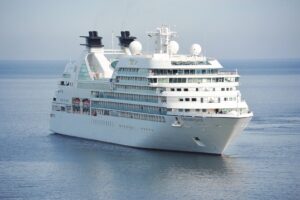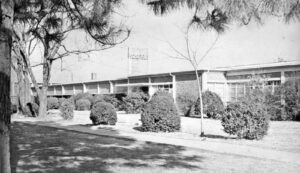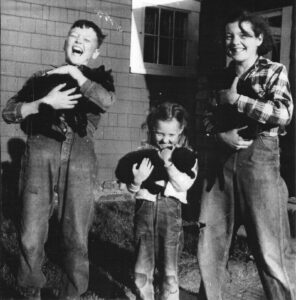D-Day, the 6th of June 1944
The Allied Invasion of Normandy
by Kathy Huff Cunningham

The United States of America entered World War II on December 11, 1941, when Congress declared war on both Germany and Japan. Four days earlier, the Japanese had attacked the U.S. Pacific fleet anchored at Pearl Harbor, Hawaii. The years-long neutral stance of the country gave way to full military involvement in both the European and Pacific theaters from that day forward. Our enemies were defeated in 1945, but not without grievous losses to American forces and overseas Allies, and the world was forever changed.
The war in Europe had begun in 1939 when Hitler’s army marched through Belgium into Poland. Nazi Germany rolled over country after country, staking out its swastika banner on most of mainland Europe as well as North Africa and huge sections of western Russia. Italy was its ally; Spain, Portugal, Switzerland, and Sweden were neutral. In 1940, Britain, battered and weak from the blitzkrieg, was fighting valiantly against great odds.
Although the British Expeditionary Force and other Allies fielded forces to prevent a Nazi takeover of France, in 1940, the outnumbered troops retreated from a German onslaught and found themselves stranded on the beaches at Dunkirk in France. There they were saved, thanks to British naval vessels and a vast flotilla of civilian watercraft. This “miracle of Dunkirk” rescued 198,000 British troops and 140,000 French and Belgian troops to the safety of England, but left France virtually undefended.
Germany First
With war declared on two fronts, America’s leaders made the decision to focus on defeating Germany first. At a series of top-secret summit meetings between Allied leaders – the USA (President Franklin D. Roosevelt), Britain (Prime Minister Winston Churchill), and Russia (Joseph Stalin) – it was agreed that the Allies would mount an invasion to liberate France and relieve the pressure of continuing German attacks on Russia. As the fighting wore on and the invasion was postponed, Stalin’s demands for a second front became more strident. However, the United States was still gearing up for war, and the equipment to land forces on the French beaches hadn’t been made yet, two factors that delayed the desired invasion.
Despite delays, plans were being made. Dwight D. Eisenhower had been placed in charge of the U.S. Army’s war plans division in December 1941 and was commissioned to design an operation for Allied victory.
Many plans for a d-day (designated day) were scrapped or postponed because of various developments in the fighting – the American invasion of North Africa in 1942, for example. Finally, a decision was reached at the Tehran conference in December of 1943 for an unalterable invasion date of May 1944. In return for the second front, Stalin agreed to mount a simultaneous offensive in eastern Europe and also pledged to join the war against Japan after Germany had been defeated.
Operation Overlord
In January 1944, Eisenhower was named Supreme Allied Commander. Operation Overlord, the code name for the invasion of Normandy, was set up to be a simultaneous attack of Allied forces on five Norman beaches by five divisions – two American, two British, and one Canadian. These divisions were assigned to beaches with the code names (from west to east) of Utah, Omaha, Gold, Juno, and Sword. In addition to the assault from the sea, two U.S. airborne divisions would support the effort to the west by landing behind the designated assault area, and one British airborne division to the east. Amphibious armor would swim ashore with the first waves. To support the troops, nearly 6,500 ships and landing craft would participate, carrying nearly 200,000 vehicles and 600,000 tons of supplies during the first three weeks.
To lay the groundwork for a successful invasion, an intricate deception was put into place to persuade the Nazis that the invasion would take place near Pas-de-Calais, opposite Dover, the narrowest point between England and France. An air campaign dropped bombs away from the real invasion area to confuse the Germans and also to disrupt their anti-invasion preparations. Allied radio transmissions relayed false information about a fake army, supposedly based in southeast England and commanded by George S. Patton. Additionally, the Allies had cracked the code for German radio transmissions and learned the deployment location of German troops ready to counterattack. On the night of the actual invasion, airborne radar deception led the Germans to believe they were viewing a picture of an invasion fleet crossing the Channel narrows, while radar blackouts disguised the real transit to Normandy.
Advance military preparations for the invasion included the deployment of 11,000 aircraft that flew 200,000 sorties between April 1 and June 5, dropping 195,000 tons of bombs on various French rail centers and roads, German airfields and military bases, radar stations, and artillery batteries along the coast, all to hinder Nazi mobility toward the beaches. All major bridges over the Loire and Seine Rivers were destroyed or broken during this air campaign, isolating the invasion area from the rest of France.
For some time, Hitler had downplayed the threat of a cross-channel invasion because he was preoccupied with the fronts in Russia and in the Mediterranean. But by the end of 1943 he acted against a possible invasion of northern France by appointing Field Marshal Erwin Rommel first as inspector of coastal defenses and then as commander of Army Group B to reinforce the Nazis’ Atlantic Wall, a 2,400-mile-long fortification of bunkers, landmines, and beach and water obstacles. Rommel succeeded in adding four million more land mines to the beaches before D-Day. However, he was unable to persuade Hitler to position German tanks close to the beaches, a failure that allowed the Allies to land with limited opposition on many of the beaches and penetrate deeper into France during the battle.
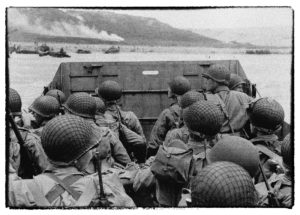
The Enormous Undertaking
By May it was apparent that difficulties in assembling landing craft would necessitate a postponement of D-Day that month. Eisenhower laid down an unalterable attack date of June 5, but bad weather in the days leading up to it jeopardized a successful landing, forcing the D-Day invasion back to June 6. A forecasted weather break allowed an armada of 3,000 landing craft, 500 naval vessels, and 2,500 other ships to leave British ports on the morning of June 5, bound for a heavily fortified 50-mile stretch of beach along the Norman coast of France.
Ahead of the naval invasion, 882 British aircraft carried parachutists and towed gliders to the Normandy landing zones and successfully secured bridges and exit roads. (They were only part of the 13,000 Allied aircraft that were directed to support D-Day; the Germans deployed fewer than 400.) Although they ultimately secured their objective, the American 82nd and 101st airborne divisions suffered many deaths by drowning when they dropped into a part of the Cotentin Peninsula that had been deliberately flooded.
Seaborne troops, 156,000 strong, arrived on the beaches around 6:30 a.m. Light opposition was encountered and overcome by the British and Canadians on Gold, Juno and Sword beaches; the same was true for the Americans at Utah Beach. Omaha Beach was a different story. The U.S. 1st Division confronted the German 352nd coast division, which killed hundreds of soldiers wading to shore from the landing craft. However, the ingenuity of the Allied troops led to ways to neutralize or destroy the enemy’s holdings, and eventually the troops got to their inland objective, albeit at a sacrifice of 2,000 men.
Allied Success
D-Day was the largest amphibious assault force in the history of the world. The overall favorable outcome of the invasion was aided by many factors: the absence of Rommel, who was home on leave for his wife’s birthday and a meeting with Hitler; Hitler’s unwillingness to release armored divisions for a counterattack until it was too late, and the scattered deployment of German troops and equipment in small units sent to ascertain the objective of the overnight parachutists rather than to the beaches.
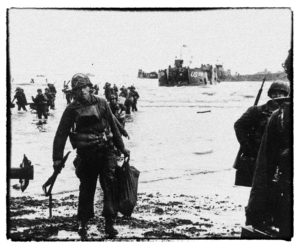
The divided German forces were the victims of their own superior officers’ confusion and unpreparedness, and the convoluted chain of command. Even when the German high command finally understood the vastness of the amphibious attack and issued sensible orders, the superiority of the Allies’ air support had already taken out key bridges and roads, forcing the Germans to take long detours to the battle and fight advancing Allied troops along the way. Perhaps more remarkably, the Germans had no reinforcements at all, whereas the Allies brought in wave after wave of fighting men.
German resistance continued, but by June 12, the Americans were able to join their British and Canadian counterparts along a secured coastline. By this time, there were 326,000 troops in France, more than 50,000 vehicles, and more than 100,000 tons of equipment.
The critical port of Cherbourg was seized at the end of June. By that time, the Allies had 850,000 troops and 150,000 vehicles in France. By August, the Germans had been eliminated from all of northern France, and Paris had been liberated. The Allies’ relentless march across France forced the Germans into a defensive posture to protect their homeland, which was also being threatened by Soviet troops advancing from the east. The Battle of D-Day had achieved its objective. D-Day casualties in numbers: The Allied casualty figures for D-Day have generally been estimated at 10,000, including 2.500 dead. Broken down nationality , the D-Day casualty figures are approximately 2,700 British, 946 Canadians , and 6,603 Americans. (Source: Telegraph in the UK)
Over the three months comprising the battle of Normandy, begun ad D-Day on June 6, more than 425, 000 Allied and German troops were killed, wounded or went missing. This figure includes more than 209,000 Allied casualties, with nearly 37,000 dead among the ground forces and 16,714 deaths among the Allied air forces. (Source: Telegraph in the UK)
Germany surrendered unconditionally less than a year later, and on May 8, 1945, all of Europe – indeed, nearly the whole world! – celebrated VE Day (Victory in Europe).
June 6, 2019, is the 75th anniversary of D-Day, the battle that was the beginning of the end of war in Europe. Today it is still commemorated by veterans and survivors of World War II, but not forgotten by people the world over who stood to lose their liberty to Nazi domination if not for the brave troops who stormed the beaches of Normandy that day.
Sources: The Encyclopedia Brittanica and History.com
Photos by Pixbay and Goodfreephotos
Reverend John B. McCullough’s Wartime Service as a Naval Chaplain
[Editor’s note:] Aiken had many sons serving the United States in that horrific D-Day battle. One served as a naval chaplain. The Rev. John B. McCullough, minister of St. Paul’s Lutheran Church, watched over the sheep of his flock aboard the USS Albemarle as they prepared for battle; some died in defending the free world, but many lived to carry on.
Fortunately, Rev. McCullough saved all of his sermons from his naval career, and select ones have been collated by his daughter, retired Aiken teacher and author, Lily Grace McCullough Baumil, into a small volume called Lord, What Shall I Say to Them for Thee? A Collection of Sermons. The following descriptions and sermons are excerpted with permission from that book for a spiritual glimpse into the legacy of D-Day.
As a member of the clergy, the Rev. John B. McCullough was one of a small and diminishing number of males remaining in the tiny town of Aiken, South Carolina, as World War II progressed. Having graduated from the University of South Carolina and the Lutheran Theological Seminary, Rev. McCullough, by 1942, had just completed his first year as pastor of St. Paul’s Lutheran Church, when he entered the U.S. Navy as a chaplain, eventually spending three years in the Atlantic and Pacific Theaters on the seas and on five continents. Throughout his more than 30 years at St. Paul’s, Rev. McCullough alluded frequently and fondly in his sermons to his experiences in the Navy.
The USS Albemarle was commissioned in 1940 and served for 20 proud years, seeing action throughout WWII in both the Europe-Africa-Middle East and the Asiatic-Pacific Theaters. Her main purpose was to patrol the coasts, conducting anti-submarine watches with her squadrons of seaplanes, which she was capable of bringing onto her fantail for repairs.
It is May of 1944. There is heavy Allied bombing on the European continent in preparation for D-Day, and at sea the 1135 men aboard the USS Albemarle find themselves in enemy waters, often perilously close to and even surrounded by enemy submarines. One can only imagine the heavy and frightened hearts of these sailors as they attend Sunday church services aboard the ship. The young chaplain’s sermon on Mother’s Day, May 14, 1944, is about young men and their visions. The hymns are strong and stirring: “All Hail the Power of Jesus’ Name,” “Jesus Calls Us, O’er the Tumult,” “Faith of our Fathers.” And in the prayer, these words: “O God, on this day at sea, far from home and loved ones, we remember Mother on this her day. It is she who gave us life; it is she who put us on Thy path; it is she who prays without ceasing for our safety.”
Sermon from the USS Albemarle
June 1944
A few weeks later, on June 11, 1944, right after D-Day, the same chaplain leads the officers and enlisted men of the Albemarle in worship. The scripture is Psalm 46: “God is our refuge and strength, a very present help in trouble…” And the prayer concludes: “Shelter our homes, O God, and all the loved ones there. Send down Thy peace to every family on earth; and, if it be Thy will, bring us safely home again.”
TRUST IN GOD
Preached on June 11, 1944 aboard the USS Albemarle
Last week a nation – yes, a whole world – kneeled in prayer. Captains and kings urged their men to battle and their people to prayer. It was D-Day, and people flocked to their places of worship. Church bells rang at 3:30 in the morning; by 4 AM many churches in every town were lighted, and in every church the people prayed. It was a personal prayer – a prayer for a son, a husband, a father, a sweetheart, or a friend. Because things were happening far away, things that were not in our hands; then, as never before, people realized that prayer was a great weapon; that now, as never before, it must be in God that we trust.
IN GOD WE TRUST – FOR OURSELVES AS INDIVIDUALS. We know now that we must trust in God, because if we trust in ourselves and in our own strength, the Lord only knows where we shall wind up. Maybe it does take hard times to make us realize what we should have known all the time – that we are just men in the hand of God. Sometimes, when we look at what we have done and get all puffed up and self-satisfied and complacent, we feel that we are all right and can look out for ourselves. At the Air Station I would see that attitude. But then a plane would come back full of bullet holes with dead and dying men on board. Other planes would go out and never come back. And the attitude changed. Men saw that it wasn’t always skill that could save them; they knew that God’s hand was with them, and God’s hand alone could protect and shield them, that it was in God that they would have to put their trust. In Proverbs, Chapter 3, we are admonished: “My son, forget not my law…Trust in the Lord with all thy heart and lean not on thy understanding. In all ways acknowledge Him and He will direct thy paths. Fear thou not, for I am with thee; be not dismayed, for I am thy God and will strengthen thee.” In God we trust for ourselves.
IN GOD WE TRUST FOR THOSE FAR AWAY. We have people far from us. Some are facing danger in battle; others are at home. And when we recognize our helplessness, our own inability to aid and support them as they are in peril and under crises, we know that they are in God’s hand. On this day at sea, we thank God for our homes where our loved ones and our hearts are, and for the family love and peace and cheer which follow us to comfort us in strange and distant places. We are grateful for all the things we shared in common: the lessons that we learned, the hardships and grief we bore, the affection and prayers that still keep our spirits strong. In God we trust for those far away.
IN GOD WE TRUST FOR OUR NATION. We know that our nation and its future are in God’s hand. And so we pray to God for those in authority in our government and those in command of our forces that they may be given wisdom and strength and courage to direct our nation and to lead our men. Someone asked Abraham Lincoln, “Don’t you pray that God is on our side?” Lincoln replied, “ No. I know that God is always on the side of the right. What I am concerned about is that we be on the side of God.” On June 6, 1944, King George VI of England broadcast a quietly spoken speech on the radio: “I declare solemnly to call my people to prayer and dedication… We shall not ask that God may do our will, but that we may be enabled to do the will of God.” In God we trust for our nation.
God of our fathers, known of old,
Lord of our far flung battle line,
Beneath whose awful hand we hold
Dominion over palm and pine –
Lord God of Hosts, be with us yet,
Lest we forget – lest we forget!
The tumult and the shouting dies;
The captains and the kings depart:
Still stands Thine ancient sacrifice,
An humble and a contrite heart.
Lord God of Hosts, be with us yet,
Lest we forget – lest we forget!
Far-called, our navies melt away;
On dune and headland sinks the fire:
Lo, all our pomp of yesterday
Is one with Nineveh and Tyre!
Judge of the Nations, spare us yet,
Lest we forget – lest we forget!
For heathen heart that puts her trust
In reeking tube and iron shard,
All valiant dust that builds on dust,
And guarding, calls not Thee to guard,
For frantic boast and foolish word –
Thy mercy on Thy people, Lord!
– Excerpts from Recessional by Rudyard Kipling 1897.
(Rudyard Kipling was asked to write a poem for Queen Victoria’s Jubilee celebration. He said later that this poem, originally published as “The Recessional,” gave him more trouble than anything he ever wrote. It was later set to music, and many know this stirring hymn from having sung it in church.)
Rev. McCullough remained an officer in the US Navy Reserves, and he delighted in attending reunions of the Albemarle and served as the group’s chaplain and publisher of the newsletter. At the last reunion he attended, on May 22, 2000, Chaplain McCullough offered this prayer:
O Almighty God, Who has given us all that we have, to enjoy and to treasure: Today we give to You a thunderous “Thank You” for so many moments to remember and to relive.
It’s been a long time now since the “Able Mable” was our home, our shelter from the stormy seas, our opportunity to serve our country; but still our minds travel back over the years to those rolling weather decks where we strived to keep our footing and to that cavernous hangar deck where we saw our movies; to the bosun’s whistle and to the stern order to “Turn to, Turn to” after lunch; to the penguins in the Galapagos and to those sunken ships in Casablanca; to the golden churches of Bahia and to the lifting docks of the Panama Canal; to the rainy heavens over England and to those sunny beaches of Trinidad; to that familiar voice of the Officer of the Deck and to the taunting, threatening airborne voice of Axis Annie; to the icy waters of Reykjavik and to the coral reefs of the Bikini Atoll. Yes, Lord, those were important days and precious memories, and we thank You for giving them to us.
We are all too aware today that there were among us then those whom we loved for a while and lost, friends whom we shall see no more upon this earth, shipmates who have dropped anchor in a better harbor. Our lives are the richer for having touched and been touched by theirs, and we are grateful.
This month, in many places, there are ceremonies commemorating D-Day, the military operation that turned the tide against the Nazis on June 4, 1944, and in so doing, “saved the world for democracy.” Less than a year later, World War II ended when the Nazis surrendered.
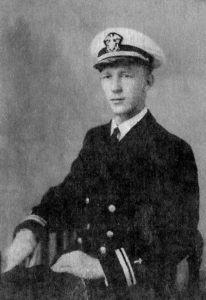
Chaplain McCullough
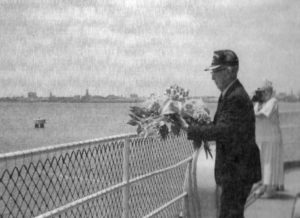
Chaplain McCullough at USS Albemarle reunion, Patriots Point, Mt. Pleasant, South Carolina
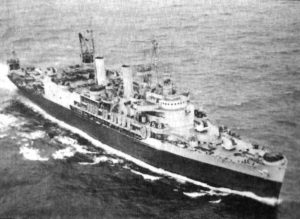
USS Albemarle


